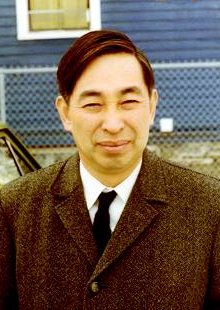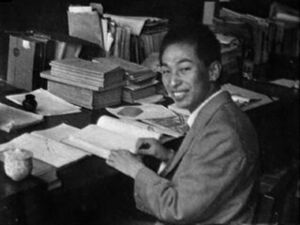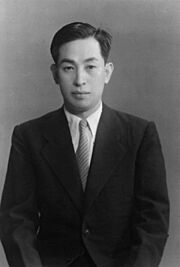Kiyosi Itô facts for kids
Quick facts for kids
Kiyosi Itô
|
|
|---|---|

Itô at Cornell University, 1970
|
|
| Born | September 7, 1915 Hokusei, Mie, Empire of Japan
|
| Died | November 10, 2008 (aged 93) |
| Alma mater | University of Tokyo |
| Known for | Itô calculus |
| Awards | Asahi Prize (1977) Wolf Prize (1987) Kyoto Prize (1998) Gauss Prize (2006) |
| Scientific career | |
| Fields | Mathematics |
| Institutions | University of Kyoto Cornell University |
| Doctoral advisor | Shokichi Iyanaga |
| Doctoral students | Shinzo Watanabe |
Kiyosi Itô (伊藤 清, Itō Kiyoshi, born September 7, 1915 – died November 10, 2008) was a Japanese mathematician. He made very important discoveries in probability theory. This is a branch of math that deals with chance and random events.
He created the idea of the stochastic integral and stochastic differential equation. These are key parts of what is now called Itô calculus. He also connected these ideas to differential geometry, which is about shapes and spaces. His work was so helpful in financial mathematics that some people called him "the most famous Japanese in Wall Street."
Itô worked at the University of Kyoto for most of his career. He even became the head of their Research Institute for Mathematical Sciences. He also spent many years teaching and researching at universities in other countries, especially at Cornell University.
Contents
Itô's Big Ideas in Math
Kiyosi Itô was a pioneer in the math of stochastic integration and stochastic differential equations. This field is now known as Itô calculus. The main idea is the Itô integral. One of his most important discoveries is a formula called Itô's lemma. This formula helps change variables in complex math problems.
Itô also helped study how things spread or move randomly on curved surfaces. This field is called stochastic differential geometry.
How Itô Calculus Is Used
Itô calculus is a math tool used to study random events. It is used in many different areas. It is perhaps best known for its use in mathematical finance. For example, Itô's lemma is used to create the Black–Scholes equation. This equation helps figure out the value of financial options.
Itô's math methods are also used in other fields. These include biology and physics. His discoveries help with population models, white noise, chemical reactions, and quantum physics. They are also used in other math subjects like differential geometry and partial differential equations.
Other experts recognized Itô's genius. Mathematician Daniel W. Stroock said Itô's work "explained things that were unexplainable before." Economist Robert C. Merton found Itô's work "a very useful tool" for his own award-winning research.
About His Name
Even though his name is often spelled Kiyoshi Itō, he preferred Kiyosi Itô. Sometimes you might also see it spelled Itoh or Ito.
Kiyosi Itô was married and had three daughters.
Kiyosi Itô's Life Story
Kiyosi Itô was born on September 7, 1915. He grew up in a farming area west of Nagoya, Japan. This was the town of Hokusei-cho in Mie Prefecture. He was a very good student from a young age.
He went to the Imperial University of Tokyo. There, he studied mathematics. He became very interested in probability theory, which was not a very developed field at the time. He graduated in 1938.
From 1939 to 1943, he worked for the Statistics Bureau of the Cabinet Secretariat. His bosses allowed him to continue his math research there. His important paper, "On Stochastic Processes," was published in 1942.
In 1943, he became an assistant professor at Nagoya Imperial University. Here, he talked a lot with other mathematicians. During this time, he published papers that defined the stochastic integral. These papers also set up the basic ideas for Itō calculus. He earned his Doctor of Science degree in 1945.
Working During Difficult Times
Itô published his work even though life was hard in Japan during World War II. It was difficult to get to libraries. It was also hard to connect with mathematicians from other countries. For example, another Japanese mathematician had to read a copied paper while in a military camp.
After the war, during the Occupation of Japan, there were still problems. Once, there was not enough paper. So, a long article by Itô had to be published in an American journal instead of a Japanese one. Itô later called his time at Nagoya "the dark age of World War II and its aftermath."
After the war, he kept developing his ideas on stochastic analysis. He wrote many important papers on the subject. In 1952, he became a professor at the University of Kyoto. His most famous book, Probability Theory, came out in 1953.
Itô stayed connected with Kyoto University until he retired in 1979. However, starting in the 1950s, he spent a lot of time outside Japan. He was at the Institute for Advanced Study from 1954 to 1956. He also taught at Stanford University (1961-1964) and Aarhus University (1966-1969).
From 1969 to 1975, Itô was a professor of mathematics at Cornell University. This was his longest time working outside Japan.
Itô wrote in Japanese, Chinese, German, French, and English. However, he admitted that his accent made it hard for Americans to understand him when he spoke English.
When Itô returned to the University of Kyoto from Cornell, he became the director of their Research Institute for Mathematical Sciences. After he retired, he became a professor emeritus at Kyoto University. He also taught at Gakushuin University for several years. This is a common practice for high-ranking Japanese academics after retirement.
Awards and Later Life
Kiyosi Itô received many important awards. These included the Wolf Prize and the Kyoto Prize. He was a member of the Japan Academy. He was also a foreign member of the Académie des sciences in France and the National Academy of Sciences in the United States.
In his later years, Itô had poor health. In 2006, he received the first-ever Gauss Prize. This award was given by the International Mathematical Union for his lifetime achievements. Because of his health, he could not travel to Madrid to accept it. So, his youngest daughter, Junko Ito, accepted the prize from King Juan Carlos I for him. Later, the president of the International Mathematical Union personally gave the medal to Itô in Kyoto.
In October 2008, Itô was honored with Japan's Order of Culture. An awards ceremony for this honor was held at the Imperial Palace.
Kiyosi Itô passed away on November 10, 2008, in Kyoto, Japan. He was 93 years old.
See also
 In Spanish: Kiyoshi Itō para niños
In Spanish: Kiyoshi Itō para niños
- Itô calculus
- Itô diffusion
- Itô integral
- Itô–Nisio theorem
- Itô isometry
- Itô's lemma
- Black–Scholes model






